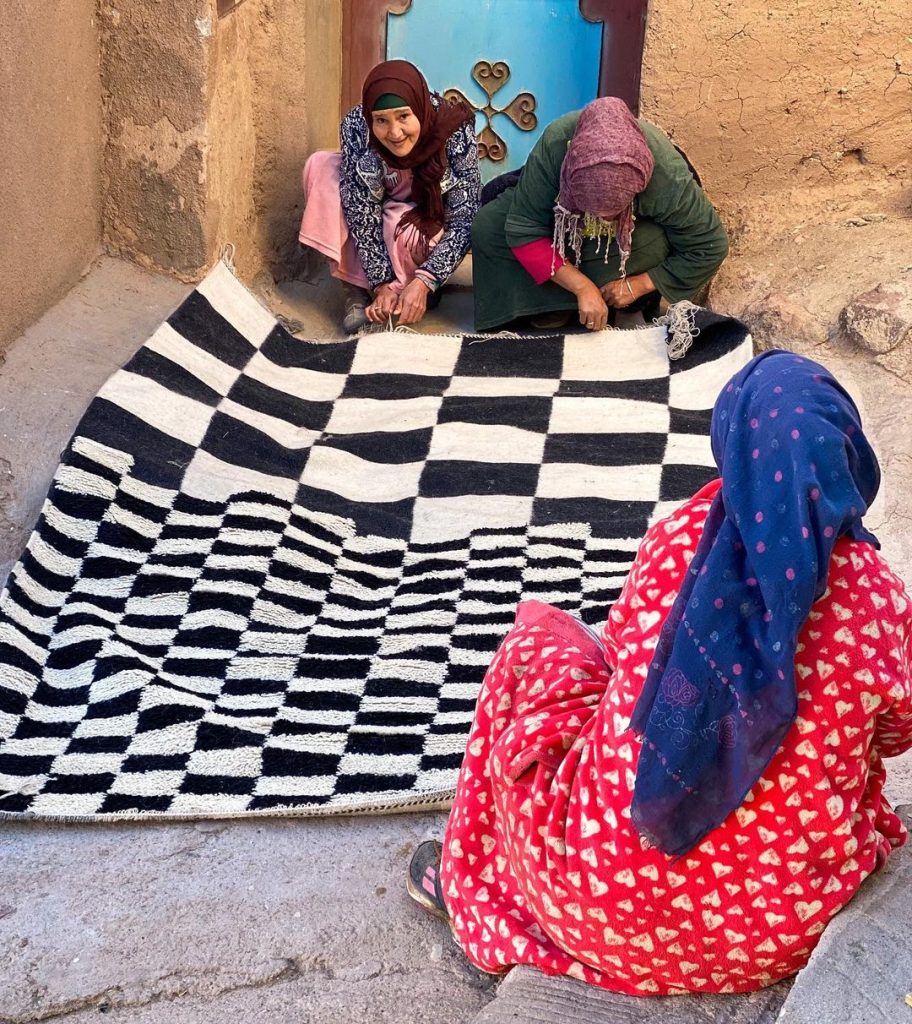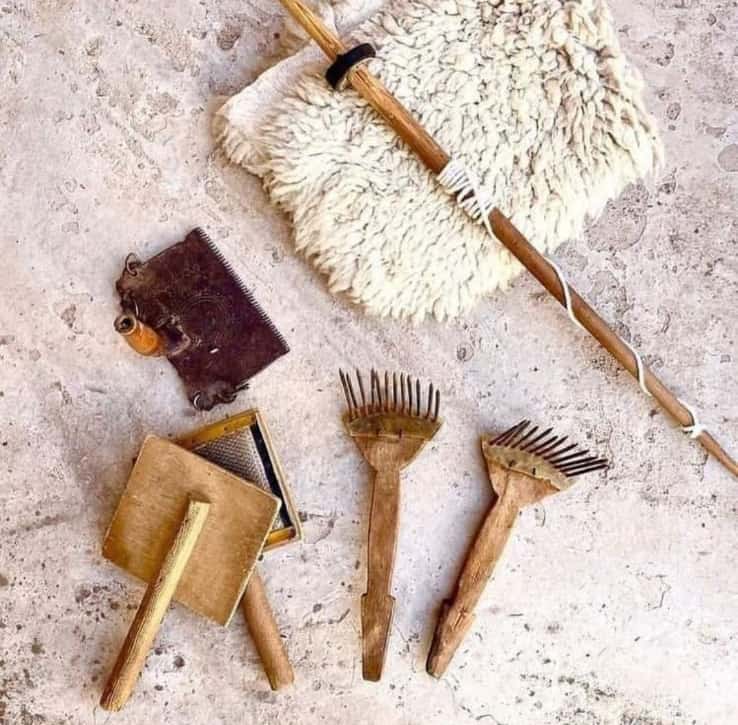The stages of weaving Moroccan Berber carpets, the steps, and the complications, provide you with the best quality in traditional and geometric colors that make your space a unique painting.
Wool, as we know, is a raw material that requires patience to provide, as the stage of preparing wool begins from raising and grazing sheep in the rugged mountains to the stage of shearing sheep herds specifically in the spring.
1. April season: sheep wool shearing is accompanied by a traditional ritual passed down through the generations to the ancestors.
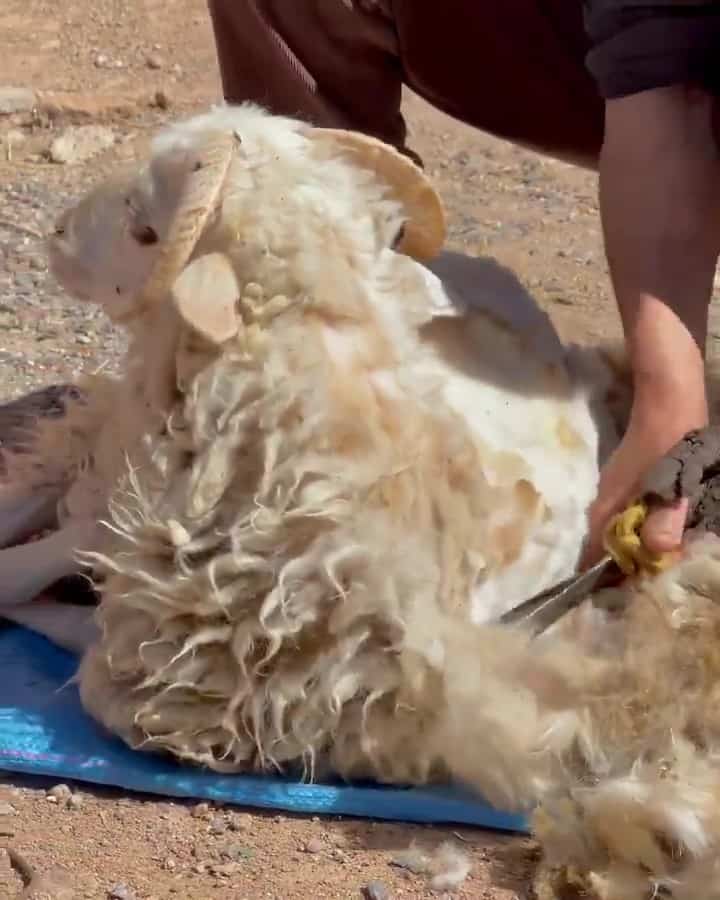
Traditional rituals, celebrations, and feasts. Breeders are keen to cut their wool before the beginning of summer with the help of volunteers.. and wool cooperatives turn it into threads to be used in home craftsmanship.
This process acquires a special and distinctive character that is inherited by the generations of the Atlas Mountains, and they consider it a day o
Traditional rituals, celebrations, and feasts.. Breeders are keen to cut their wool before the beginning of summer with the help of volunteers.. and wool cooperatives turn it into threads to be used in home craftsmanship.
This process acquires a special and distinctive character that is inherited by the generations of the Atlas Mountains, and they consider it a day of joy and celebration, which the old and small breeders are keen on, despite the fact that they do not benefit financially from the quantities of wool produced, as it is sold at cheap prices to traders due to the difficulty of marketing it, while some exploit the wool at home in The kilims and the blankets are made by hand, after converting the wool to the yarns of the wool cooperatives at the Center for Sustainable Development, for a small fee.
The season of sheep wool shearing in the Atlas Mountains tribes begins at the end of April of each year and continues until the beginning of the summer. grandparents.
The tribes are keen to practice traditional rituals during the “jalameh”, despite the modernity, changes, and developments that have brought about many legacies, and some senior sheep breeders turn this occasion into a big celebration during which they set up “Arab houses” or large tents, to receive guests who come from different regions to witness the event and sacrifices for them.
f joy and celebration, which the old and small breeders are keen on, despite the fact that they do not benefit financially from the quantities of wool produced, as it is sold at cheap prices to traders due to the difficulty of marketing it, while some exploit the wool at home in The kilims and the blankets are made by hand, after converting the wool to the yarns of the wool cooperatives at the Center for Sustainable Development, for a small fee.
The season of sheep wool shearing in the tribes of the Atlas Mountains begins at the end of April of each year and continues until the beginning of the summer.
The tribes are keen to practice traditional rituals during the “jalameh”, despite the modernity, changes, and developments that have brought about many legacies, and some senior sheep breeders turn this occasion into a big celebration during which they set up “Arab houses” or large tents, to receive guests who come from different regions to witness the event and sacrifices for them.
2. Drying the wool, then blowing it manually, in addition to dismantling all knots from it, in order to facilitate its spinning.
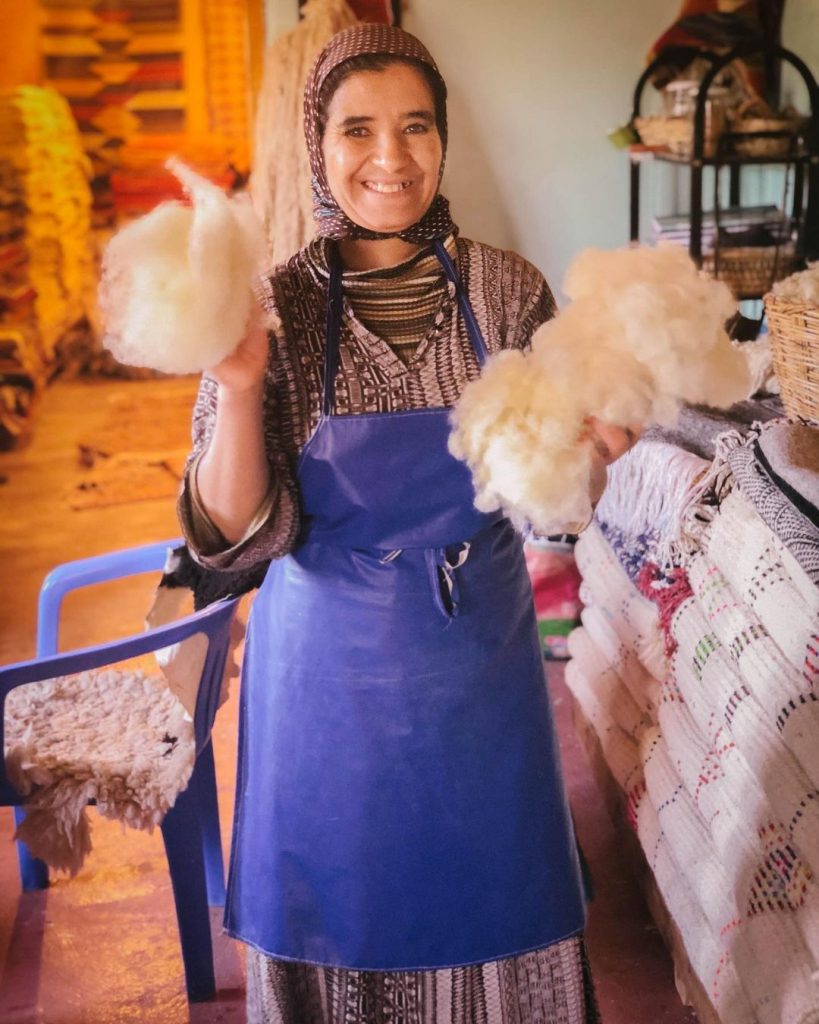
Here the man’s role ends. The women begin to perform their tasks so that the woman wishing to complete some kind of weaving (a carpet, a Hanbal, a Handira, a tent…) would gather the wool in bags to start washing it by taking it to a river next to the tribe, or a water source whose flow is strong, cool and soft, This helps to maintain the whiteness of the wool, its softness, and ease of purification. As soon as the woman arrives, she puts the wool in a water basin for a period of time that extends from one to two hours and then proceeds to wash it partially after placing it on a smooth rock and beating it with a heavy stick until the wool appears white and free of impurities, and makes sure of that after pouring water on the Wool, which should appear fine. A woman cannot start weaving until she has confirmed the validity and luster of the wool. The wool keeps and preserves the signs of the past, the fingerprints of the hands, and the glances of the eyes. These are the features that the carpet testifies to its history.
Berber women involve their daughters in everything related to weaving, from washing wool to removing the woven piece. The step of drying the wool is one of the processes in which girls become a privileged participant as if their mother wanted them to practice the trades of a married woman. The woman and her daughters, then, wait for the wool to dry, to collect it, again, in sacks, and prepare for the next operations. Therefore, she spreads it on a mat on sunny days, after it became clear to her that the wool had lost its remaining water. The woman seeks to make sure that the wool has dried completely and is saturated with the heat of the sun.
3. Spinning wool by hand is called the process of shearing, To become in the form of a long, twirled thread of wool.
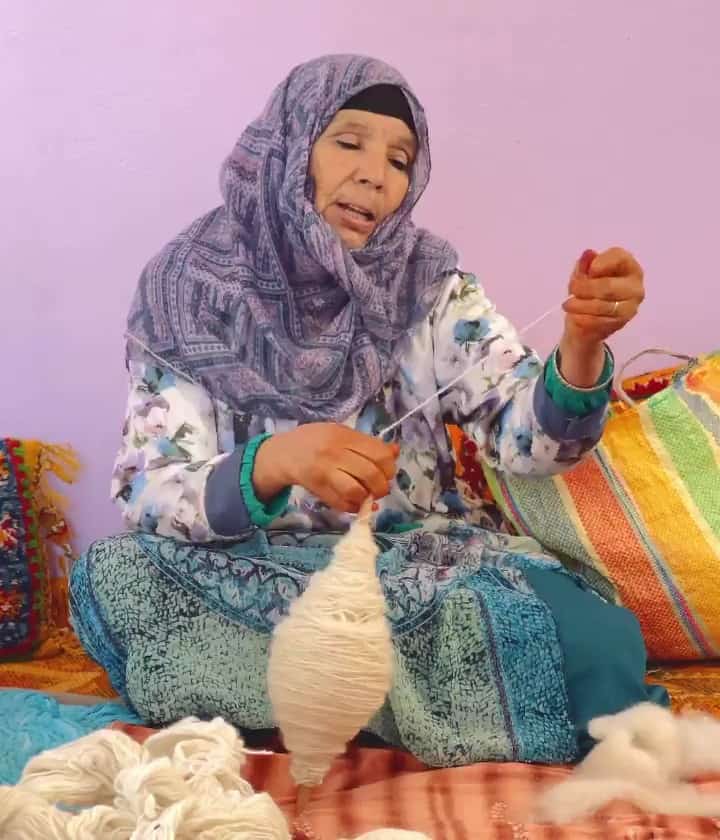
It is important for the woman to sit on the ground to begin the process of styling the wool, which has taken on a bright white color, using traditional tools called (Iqarchaln Iquarchaln).
The woman then resorts to holding this tool (it has sharp teeth that transform wool into threads) with her two hands together, and she proceeds to this process through a dynamic movement of the hands that is embodied in pushing one of them forward and the other back in an opposite manner, a process that requires strength and focuses and permeates in some Sometimes chanting some songs helps to focus more on one hand or to relieve fatigue on the other hand. As soon as she finishes styling a woolen sheet, she puts it on another and then collects it in bags as soon as she feels that she has layered a large amount of wool and reached the strength of the needed number of wool ingots (Telazyine) to put it in the “Lakhzine storage” and leave it there for a considerable period of time considering The wool (Tadouft) stored increases in frequency the more it is stored, as they think.
In other cases, the woman postpones this process until after the winter season, when she resorts to taking out the stored wool for ventilation by means of the spring sun, and she proceeds to convert the wool into alloys and spectra due to the friction between my husband (Iqrashalin) resulting from the movement of the back and forth of the weaver’s hands. On the one hand, and on the other hand, thanks to the sharpness of the teeth of this traditional tool, which results in the dismantling of the wool into thin threads that are arranged in the form of plates, which are then collected in bags or boxes. It is an individual behavior, and it may be collected in the case of Tawiza, which depends on the physical effort of the woman because it is repetitive in its movement, and it is based on a superior mental focus to the degree of emotional interdependence with it despite the fact that the woman is aware of that. It is a behavior with values linked to personal and social choices.
While doing this process, the emotional bond between the woman and the wool and this tool is very strong, as we notice a kind of intimate fusion between these three elements, so the wool and the tool together turn into a part of the same weaver woman to form, through all of that, a semiotic painting from which it is concluded that the woman Oranian faithful to its identity and culture. What increases the distinctive emotional dimension of this relationship is that the process of woolen styling appears as a mirror for the ouarain woman, through which she reflects her personality, which is filled with psychological energy that she empties into her relationship with wool.
Weeks after this operation, the woman returns to work again. It begins by transforming stored woolen ingots into threads using a traditional double-edged method. The first border she holds with her right hand is called “Izdi”, and the second border is held by the left hand and is called “Tazdachte”, which is a feminine Izdi, and on her head the woman attaches the first woolen plates and proceeds to transform them into these threads (this head is called “Tfourka”). ). The village lady must be able to have endurance and patience because this process requires a long time, knowing that she is the only one watching over the internal and external affairs of the house in some cases. This means that she is exposed to despair and frustration if there is no one to help her and thus she will give up her work. However, the Amazigh woman cannot enter the marital home unless she is qualified to do so and is aware, beforehand, of the responsibility entrusted to her and recognized by her.
The woman proceeds to the other stage of weaving, which is the creation of woolen threads. She resorts with her left hand to hold the “Tazdacht” and on top of it the first Sufi plate is consolidated, specifically in (Tfourka / Trokka), and she stretches it with both hands, the left holds the “Tazdacht” and the right holds the “ezdi”, which is a traditional instrument composed, which is The other, of two pieces (one of which is a circular body with a hole in the middle called “Tachrourt or La toupie)”, and the second is a trimmed pole “Fuseau” placed in the first piece) and she begins to roll it between her two fingers: the thumb and forefinger. The picture is on the side It is for “Izdi” and it is a traditional tool used by the Berber village woman to transform wool into solid threads through the process of spiraling “Izdi (Quenouille)” held in the right hand and twisting those woolen threads on it so that she can save a large amount of them called “Afskar”. (Kubba of strings), as we can see in the picture.
These threads vary into two types that are used to start the weaving process, which takes a name in the Amazigh women’s dictionary in the region, “Abaddi”, which later turns with the weaving process to become “Azetta”. One of these threads is called “Ostou” and is erected vertically, and the second is called “Olmane” and is erected horizontally.
3. Prepare basins filled with hot water, add threads to obtain multiple colors according to the area, then separate them and leave them to dry.
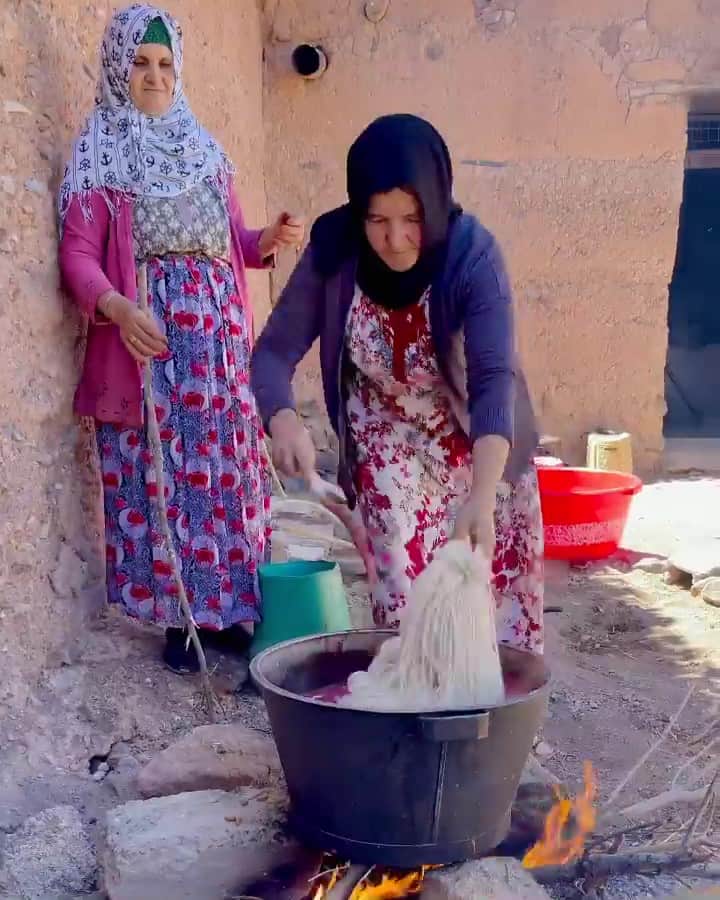
The process of dyeing wool begins with placing a large pot on charcoal containing water mixed with henna powder.
Where natural materials are used in the coloring process, such as henna, herbs, saffron, cinnamon, and other natural materials that differ according to the color to be obtained. Alum powder “(one of the Moroccan folk ingredients) has been added to the mixture, and it has a role in fixing the color on wool and its effect is effective in that You only need to adopt a longer boiling time to ensure the quality of the desired color. Then the colored wool will be exposed to the sun to dry
5. The skill of the ladies in front of the weaver to unleash their moments of joy, sadness, and imagination to create enchanting paintings.
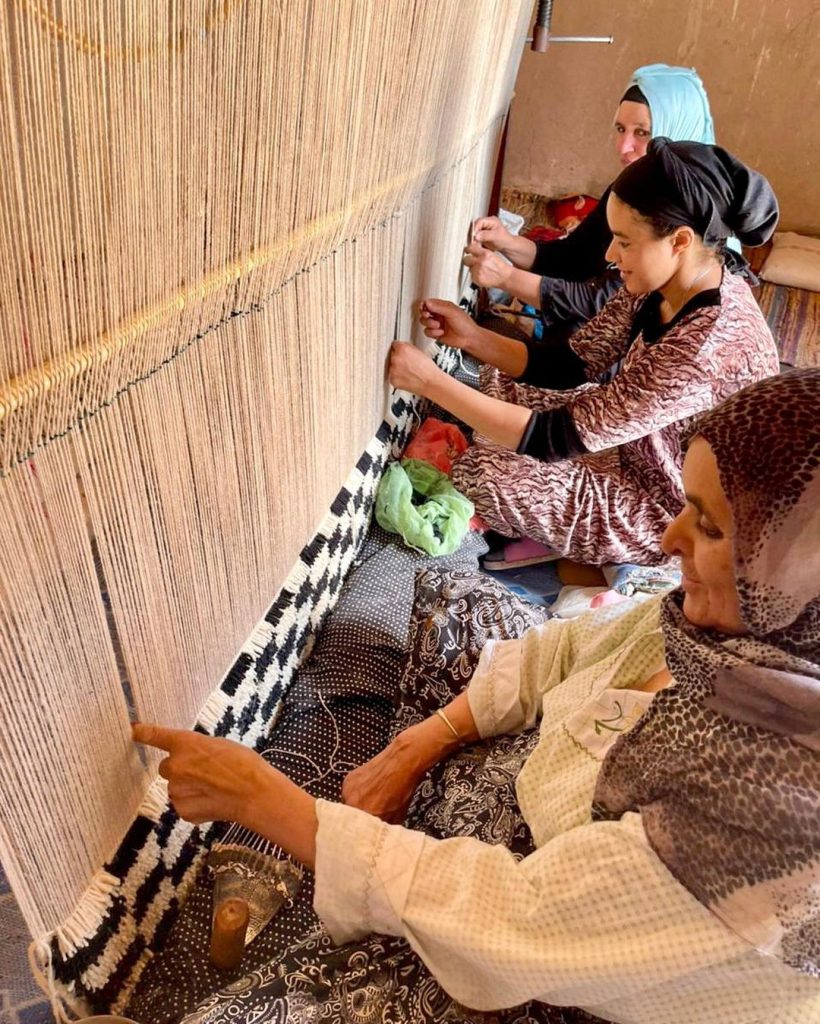
The completion of the process of preparing the woolen threads (Asto and Ullmann), which takes a long and hard work of women, and requires a high level of concentration, patience, and endurance, opens the way for the weaver to start setting up the frame of the piece to be woven, whether it is a carpet or a tent… The woman, In this regard, by installing twisted woolen threads on the opposite pegs (Izadjns), which are fixed in turn in the ground. It ends the actual and real start of the weaving process of the material to be woven (Azata wicking). In this context, the woman needs someone to help her, and at least four women, each one sitting at the corner of each stake, and the fifth perform the circumambulation from this woman to the other, holding the string in an opposite direction. Side by side, pull these pegs until the strings are firmly attached.
It is worth mentioning that the process of erecting the “azta” in its beginning is outside the house in a wide yard and on a sunny day, and every person, regardless of his gender, and coincidentally passing through the scene of the operation, does not contribute a symbolic gift (money, sugar…) with the weaver woman, calling for her incompleteness and perfection and overcoming The hardship of the material to be woven. It is a behavior that falls within the usual tribal union and solidarity among the residents of the village. Examples of these supplications are as if he was told in Tamazight: tissri y afsousn, and his performance is: Oh God, make it easy work.
The pegs are removed as soon as the threads are fixed in them, and they set the looms (Ifadjajn Les ensouples) in the appropriate place, and the “azta” is sewed on them by the stitcher. Their side until you complete it with access to them.
The woven fabrics are placed in another body called “Temantwine”, singular “Témantaft”, and they are tied with a strong rope “Asghoune”. After that, one of the women resorts to cementing the “Taghda” in the middle of “Azta” and then placing the ghanime on it. “. These traditional tools (taghda, assanni thread, ghanime les roseaux) are necessary to begin with, and the absence of one means no.
The weaving begins after replacing the stakes with reeds (ghanime or roseau) that the women remove from the ground, then the azta is cemented next to the center wall of the house and away from traffic. At this stage, the woman resorts to untangling the stalk from the thaghda, which will be placed on top of it (taghda), after she has fixed the yoke on it. Now the woman is ready to start the knitting process after preparing the tools and completing the basic mechanics of this process.
The woman sits next to the lower part of the azta and then begins weaving with a traditional tool called the Tazatcha (Peigne). This tool and other previous tools embody the personal legacy of the Berber Berber rural woman, and it is not permissible to give it to another woman for fear of losing her.
6. Carpets are constantly evolving thanks to the imagination and creativity of women, but they do not break from their roots and originality emanating from Morocco
